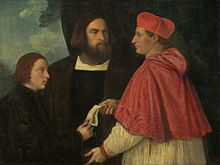Marco Cornaro (Cardinal)

Marco Cornaro (also Marco Corner ; * 1482 in Venice ; † July 24, 1524 there ) was an Italian cardinal .
Life
Origin and early years
Marco Cornaro was the third of eleven children of a Venetian patrician family from which several doges came. His parents were Giorgio Cornaro and Elisabetta Morosini. Caterina Cornaro , a sister of his father, had become queen of Cyprus through her marriage to James II of Lusignan ; his brother was the future Cardinal Francesco Cornaro the Elder .
Church career
He became an Apostolic Protonotary at an early age . Pope Alexander VI appointed him in the consistory of September 28, 1500 cardinal deacon and gave him the title deaconry Santa Maria in Portico Octaviae on October 5 of the same year . He took part in the first conclave of 1503 , in which Pope Pius III. was chosen. He was also among the participants in the second conclave of the same year, from which Julius II emerged as pope.
On November 29, 1503, Marco Cornaro became administrator of Verona and held this position until his death. In Verona he founded a seminar for 36 students. He was appointed Bishop of Famagusta in Cyprus - which at that time belonged to the Republic of Venice - on December 11, 1503 , but gave up on this diocese on July 1 of the following year. In July 1506 he was appointed Latin Patriarch of Constantinople , again resigned at the end of October 1506; after reappointment on June 11, 1521, he carried this title until his death.
Because of a war between the Republic of Venice and the Pope, he was not invited to the consistory of March 22, 1509. On January 2nd, 1511 he accompanied Julius II to the city walls of the besieged Mirandola, the city surrendered on January 20th. On January 28, 1512 Marco Cornaro was appointed legate for the Patrimonium of Petri , which was confirmed in 1513 and 1514. He managed to make peace between the Republic of Venice and Pope Julius II. In 1513 he took part in the conclave that elected Leo X as pope. In March 1519 he moved to the titular diaconia Santa Maria in Via Lata . As a participant in the Fifth Lateran Council , he was a member of the Commission for Church Reforms. On April 4, 1514 he was appointed bishop of Nemosia (today Limassol ) in Cyprus and recommended by the Pope to the Doge of Venice; however, on March 22, 1516, he resigned himself to this diocese. On March 9, 1517 he was appointed Bishop of Padua , which he held until his death. In September 1520 he was also archpriest of the Vatican Basilica and from December 2, 1520 he was cardinal protodeacon . He took part in the conclave 1521-1522 , after the end of which he on January 9, 1522 Hadrian VI. when announced the new Pope; he also crowned it on January 31st in St. Peter's Basilica . He took part in the conclave of 1523 and crowned this Pope as cardinal protodeacon on November 26, 1523 after the election of Clement VII . After he had crowned two popes, he was granted the right to the next vacant Suburbicarian diocese . In addition, Clement VII gave him the Palace of San Marco.
Marco Cornaro was commissioned on December 9, 1523, together with two other cardinals, to conduct an investigation into the followers of Martin Luther . He was elevated to cardinal priest of the titular church of San Marco on December 14, 1523 and on May 20 of the following year to cardinal bishop of Albano . On June 15, 1524 he moved to the suburbicarian bishopric Palestrina .
Death and burial
Nine days later, Cardinal Marco Cornaro died unexpectedly in Venice and was first buried in the local church of San Giorgio Maggiore . In 1570 his bones were transferred to a family chapel in St. Mark's Basilica .
Web links
- Cornaro, Marco. In: Salvador Miranda : The Cardinals of the Holy Roman Church. ( Florida International University website), accessed March 31, 2017.
- Entry on Marco Cornaro on catholic-hierarchy.org ; accessed on March 31, 2017.
| predecessor | Office | successor |
|---|---|---|
| Pietro Accolti |
Cardinal Bishop of Palestrina 1524 |
Lorenzo Pucci |
| Pietro Accolti |
Cardinal Bishop of Albano 1524 |
Lorenzo Pucci |
| Tamás Bakócz |
Latin (titular) patriarch of Constantinople 1521–1524 |
Aegidius de Viterbo OSA |
| Ippolito I. d'Este |
Archpriest of the Vatican Basilica 1520 |
Franciotto Orsini |
| Sisto Gara della Rovere |
Bishop of Padua 1517–1524 |
Francesco Pisani |
| personal data | |
|---|---|
| SURNAME | Cornaro, Marco |
| ALTERNATIVE NAMES | Corner, Marco |
| BRIEF DESCRIPTION | Italian cardinal |
| DATE OF BIRTH | 1482 |
| PLACE OF BIRTH | Venice |
| DATE OF DEATH | July 24, 1524 |
| Place of death | Venice |